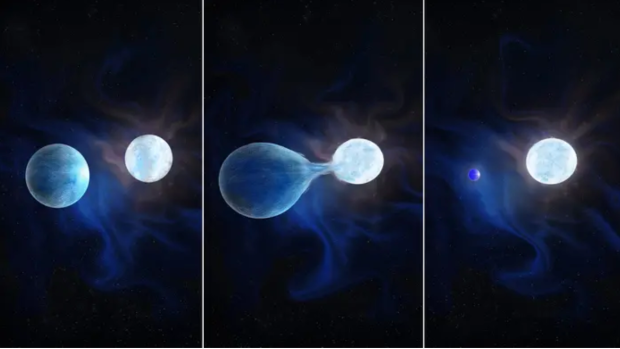Discovery of Enigmatic Stars Within Proximity of Galaxies
The cosmos is filled with a multitude of binary star systems, where two stars gracefully revolve around each other in an eternal celestial waltz. Scientists have long theorized that in one out of every three of these massive star pairings, the companion star strips away the hydrogen envelope of its counterpart, resulting in the birth of a scorching hot helium star.
The chance to observe such stars is exceedingly rare, with only one previous discovery on record. However, a recent breakthrough has allowed researchers to uncover an entire population of these unique stars in the Large and Small Magellanic Clouds, satellite galaxies of our very own Milky Way that lie relatively close by. This remarkable finding may provide valuable insights into the nature of hot helium stars, which are believed to be the precursors to neutron star mergers and hydrogen-deficient core-collapse supernovae. The study, which was published in the prestigious journal Science this month, marks a significant step forward in our understanding of these captivating stellar relationships.
Bethany Ludwig, a PhD candidate at the University of Toronto and coauthor of the study, expressed her excitement about the research, stating in a press release, “Our work illuminates the intricacies of these captivating connections, unveiling a universe that is far more intertwined and dynamic than we had previously envisioned. Just as humans thrive in social settings, it appears that stars, particularly the massive ones, seldom exist in isolation.”

Stripped stars
Astronomers have a keen interest in studying hydrogen-poor core-collapse supernovae due to their mysterious origins. The origins of these stellar explosions are not fully understood, but there are two prevailing theories. Some scientists believe that these explosions occur in stars of such immense size that their outer hydrogen envelopes are stripped away by cosmic winds. On the other hand, there is a theory that suggests binary stars play a role in the initiation of these explosions. In this scenario, one star pulls the hydrogen envelope away from its companion star. This process can take hundreds of thousands of years, as stated in a press release. Once the companion star successfully removes the envelope, only a hot helium core remains. Eventually, the star’s life will come to an end in a hydrogen-poor supernova.
Computer models indicate that approximately one-third of massive stars in the universe may undergo this stripping phenomenon. However, scientists have only observed one instance of a stripped star. These stars are challenging to detect due to their extremely faint light. The presence of surrounding dust can obscure their light, or they may be overshadowed by their companion star.
Maria Drout, the lead author of the study and an astrophysicist at the University of Toronto, emphasizes the significance of these findings. She states, “If it were to be discovered that these stars are rare, it would challenge our entire theoretical framework regarding various phenomena such as supernovae, gravitational waves, and the light emitted by distant galaxies. This discovery confirms the existence of these stars.”
On a search
The search for the elusive stars began in 2016 by the research team. Drout and her colleagues utilized data from the Neil Gehrels Swift Observatory to survey stars that can only be seen in the ultraviolet part of the spectrum. Subsequently, the team observed 25 stars using the twin Magellan Telescopes situated at Las Campanas Observatory in Chile. The team gathered data that aligns with the predictions that these stars are of low mass, lacking in hydrogen, and exist in binary systems.
These stripped stars in this newly discovered population may meet their end through a supernova explosion or a merger with a neutron star. The researchers will continue their observations of these stars and search for others not only within the Milky Way but also in nearby galaxies.
This article is republished from astronomy.com under a Creative Commons license. Read the original article.
Do not forget to share your opinion with us to provide you with the best posts !



0 Comments